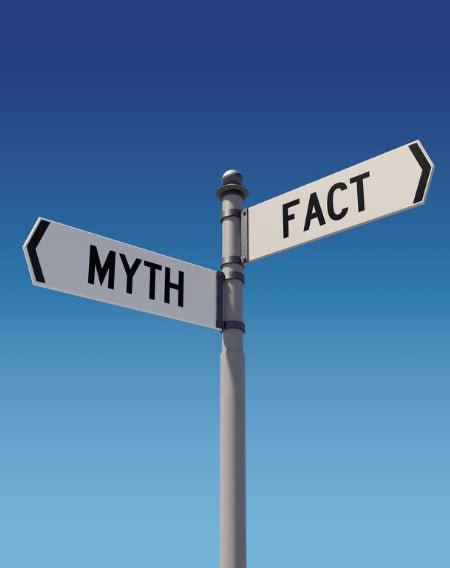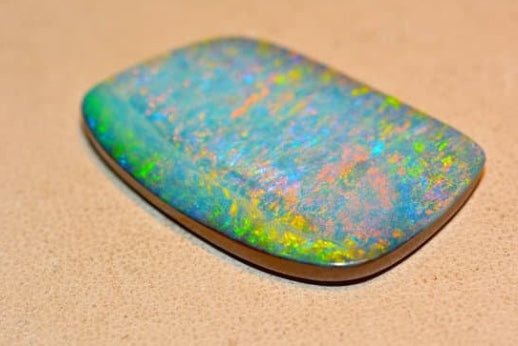
The Most Comprehensive Opal Glossary Available: Your Complete Resource
Common Opal Mining and Trading Terms
Agitator (Agi)
Often as simple as a modified cement mixer used to wash and tumble opal dirt, usually near a water source like a dam.
Amorphous
Describes gems and minerals without a definite form or crystal structure.
Artesian Basin
A large underground water source covering around 1,750,000 square kilometres in inland Australia, also found worldwide.
Automatic Hoist
A machine that lifts and tips buckets of opal dirt from underground to a truck.
Ballroom
A large cavity in an opal mine formed by removing opal dirt during the search for opal.
Bar (Colour Bar)
Describes the formation of colour in a Nobby or Seam opal.
Black Opal
The rarest and most valuable type of opal, characterised by a dark body tone due to iron oxide and carbon, which enhances the gem's colours.
Blow
A cylindrical formation in the opal level, sometimes containing opal fragments, thought to be ancient steam or pressure vents.
Blower
A machine like a giant vacuum cleaner that sucks opal dirt from underground and deposits it into a truck.
Body Tone
The scale rating of opal's body tone from dark (N1-N4 for black opal) to light (N7-N9 for light opal), with N5-N6 being semi-black.
Bogger
A small vehicle with a tipping scoop used to move opal dirt from the mine face to the shaft for transport.
Boulder Opal
Opal found in Queensland that forms on dark brown ironstone, often displaying vibrant colours.
Bummy
Slang for a stone cut with excessively large backs.
Buyer
An individual who purchases opal from miners, runners, or other buyers.
Cabochon
A gemstone cut with a domed top, smooth and rounded rather than faceted.
Calibrate
The process of cutting a stone to a standard size using a template and calipers.
Carat
A unit of weight for gemstones, where one carat equals one-fifth of a gram.
China Hat
A formation of rough opal Nobby with a peaked centre, thought to be an ancient fossilised lily.
Cleave or Cleavage
The property allowing a gemstone to break along specific planes, often irregularly in opal.
Common Opal
Opal without play-of-colour, often just a base colour like white, grey, or black.
Coocoran
A large basin near Lightning Ridge that becomes a lake during floods, also the name for the surrounding opal mining fields.
Crystal Opal
Any opal that is transparent or translucent.
Diaphaneity
The property of being transparent or translucent, often describing crystal opals.
Digger
A hydraulic machine with a digging claw used underground to mine opal.
Doublet
A slice of white or crystal opal placed on a dark backing to mimic black opal.
Dopping
The technique of attaching a stone to a stick with wax or gem glue for easier handling during cutting and finishing.
Drill
Used by miners to bore holes and explore opal-bearing ground, bringing earth and rock to the surface for inspection.
Drive
A tunnel dug to extract opal dirt, typically just below the roof to about six feet deep.
Fire Opal
Refers to Mexican Fire Opal or any opal with brilliant red/orange flashes, though not commonly used in Australia.
Fossils
Remnants of organisms replaced by opal, resulting in fossilised opal.
Gouge
Gently picking at the face to find opal, rather than digging.
Hoist
A mechanical device that lifts dirt from the mine to the surface.
Inclusion
Material like matrix, sand, or gypsum found within opal.
Ironstone
A reddish-brown rock composed of iron oxide, often the host rock for boulder opal.
Level
The strata where opal is found, commonly referred to as opal dirt.
Mohs’ Scale
The scale for measuring hardness in gems and minerals.
Mullock or Mullock Heap
Piles of opal dirt found on the surface of opal fields.
Nobby
A naturally lump-shaped piece of opal found only at Lightning Ridge.
Opal
An amorphous, non-crystalline gem mineral formed from silica deposited in ancient voids.
Opal Carving
A specialised method of cutting opal to produce uniquely-shaped gemstones with freeform shapes.
Opal Cutter
A skilled person who cuts rough or rubbed opal into polished gemstones.
Opal Dirt
Claystones in which opal is found.
Opalized Fossil
Opal filling voids left by decomposed objects like teeth, bones, or shells, forming opal fossils.
Orientation
The skill of maximising a rough piece of opal's potential in terms of colour, shape, and pattern during cutting.
Potch
Non-precious, colourless opal without gem colour.
Prop
An upright log used to support the roof of an underground mine.
Ratter
A thief who steals opal from mines, agitators, or tailings piles.
Rough
Uncut opal.
Rub
Opal that has been roughly ground to remove impurities and establish a preliminary shape.
Runner
Someone who sells opal on behalf of the owners, usually for a commission.
Saw
An automated diamond saw used in opal cutting, typically with water lubrication.
Seam
A horizontal layer of opal in the ground. Thin seams are known as ‘trace.’
Triplet
A partially man-made stone with a thin slice of opal, a dark backing, and a quartz crystal capping.
White Opal
Opal with a light body tone, typically found in South Australia.
Windlass
A winch used to haul opal dirt from the mine, now mostly replaced by automatic hoists and blowers.
Types and Varieties of Opal
Agate Opal
Banded variety of opal resembling agate.
Amatite
Opal in thick mounds from hot silica-rich springs.
Amber Opal
Opal with a brownish to yellowish background colour, resembling amber.
Andamooka Opal
Opal from Andamooka, South Australia.
Banded Opal
Common opal with colour bands, also known as agate opal.
Bandfire Opal
Precious opal with play-of-colour in wavy bands.
Belemnite Opal
Opalized fossil of ancient octopus-like sea creatures called belemnites.
Black Opal Body Tone
Ranges from N1 to N4.
Bone Opal
Opal pseudomorph after a bone.
Cachalong Opal
Opaque, highly porous type of common opal.
Cherry Opal
Orange-red to bright red variety of Mexican fire opal.
Chinese Writing Opals
Opal pattern with criss-crossed strokes resembling oriental letters.
Chloropal
Common opal with a lighter green hue.
Chrysopal
Common opal with a golden-green colour.
Claro Opal
Transparent precious opal from Mexico with intense play-of-colour.
Common Opal
Any opal lacking play-of-colour.
Contra Luz Opal
Precious opal with play-of-colour visible only when light is behind the stone.
Coober Pedy Opal
High-quality precious opal from Coober Pedy, South Australia.
Crystal Opal
Transparent to translucent precious opal where play-of-colour is visible on the surface and in the interior of the stone.
Dark Opal
Another term for black opal.
Dendritic Opal
Common opal with dark inclusions forming mossy or fern-like patterns.
Diatomite
Opal replacement of microscopic diatom shells, white and chalky in texture.
Ethiopian Opal
From newly discovered fields in Ethiopia, often porous and hydrophane.
Flame Opal
Precious opal with red streaks resembling flames.
Flash Opal
Precious opal with large colour flashes that appear and disappear.
Fossil Opal
Opal pseudomorph of organic matter like shell, bone, and trees.
Freeform Opal
A naturally shaped opal, other than an oval or round shape.
Geyserite
Opal from hot water springs, also called perlite or geyser opal.
Gilson Opal
Synthetic opal.
Girasol
Yellow or orange precious opal where the play-of-colour follows the sun.
Gold Opal
Common opal with a golden hue.
Harlequin Opal
Precious opal with play-of-colour in a harlequin or diamond-shaped pattern.
Honey Opal
Transparent to translucent opal with an orange-brown colour.
Hyacinth Opal
Another term for girasol.
Hyalite
Colourless to misty-blue common opal, fluoresces green.
Hydrophane
White, opaque opal that becomes transparent when wet.
Isopyre
Dark red opal once thought to be a separate mineral.
Jelly Opal
Transparent precious opal with a gelatinous appearance.
Lechosos Opal
Precious opal with a milky-white background and strong play-of-colour.
Lemon Opal
Common opal with a lemon-yellow colour.
Levin Opal
Precious opal with long and thin, lightning-like flashes.
Light Opal
A synonym for white opal.
Lightning Ridge Opal
Opal from Lightning Ridge, New South Wales, Australia, usually high-quality black opal.
Lithoxyl Opal
Wood opal where the original structure of the tree is very apparent.
Liver Opal
Another term for menilite.
Menilite
Opaque, greyish-brown form of common opal, also known as liver opal.
Mexican Fire Opal
Transparent opal from Mexico, usually orange or red, highly desired as a gem.
Milk Opal
Opal with a milky-white colour, can be either common or precious opal.
Monarch Opal
Man-made opal with similar appearance to natural opal, includes black potch lines or snake/honey-comb patterns.
Moss Opal
Common opal with inclusions resembling moss, also known as dendritic opal.
Mother of Opal
Precious opal with bright colour specks filling the pores of sandstone or ironstone.
Mother of Pearl Opal
Banded opal used as cameos.
Mountain Opal
Opal from igneous environments, also called volcanic opal.
Neslite
Common opal similar to menilite, but darker grey.
Nevada Opal
Opal from the Virgin Valley, Nevada, USA.
Onyx Opal
Common opal resembling banded onyx.
Opal Matrix
Thin layer of precious opal on host rock, used in jewelry.
Opaline
Synonymous with opal matrix, also an old term for Australian opal.
Opalite
Can refer to an impure form of opal, a yellow-green common opal, or an imitation opal.
Opalized Bone
Another term for bone opal.
Opalized Fossil
Another term for fossil opal.
Opalized Shell
Another term for shell opal.
Opalized Wood
Another term for wood opal.
Painted Boulder
Sandstone boulders with a coating of precious opal.
Parcel
A collection of any number of opals, either rough, rubs, or cut, that are offered for sale.
Pearl Opal
Another term for tabasheer.
Peruvian Opal
Common opals from Peru, often blue or pink, found in the Andes Mountains.
Pineapple Opal
Opal pseudomorph after ikaite, resembles a pineapple, found in White Cliffs, Australia.
Pinfire Opal
Precious opal with very small, pinhead-size colour flashes.
Pinpoint Opal
Australian term for pinfire opal.
Pipe Opal
Opal formed as a filling of long, cylindrical cavities in rock.
Pitch Opal
Yellow to brown common opal with a pitchy lustre.
Potch
Australian term for common opal.
Prase Opal
Green to dark green form of common opal.
Precious Fire Opal
Fire opal displaying play-of-colour.
Precious Opal
Any opal exhibiting play-of-colour.
Prime d’Opal
Another term for mother of opal.
Pyrophane
Precious opal with play-of-colour that wanders and reappears at random.
Queensland Opal
Another term for boulder opal.
Quinzite Opal
Rose to pink coloured opal, usually without play-of-colour.
Radiolite Opal
Common opal of a smoky-brown colour caused by radiolaria inclusions.
Rainbow Opal
Precious opal with play-of-colour seen in curved bands.
Red Flash Opal
Precious opal with red colour flashes.
Resin Opal
Common opal with a yellow-brown colour and resinous lustre.
Ribbon Opal
Opal pattern with colour running in stripes.
Rough Opal
Opal in its natural state, as it comes out of the ground.
Rumanite
Opal from Romania.
Seam Opal
Opal found in the seams or large cracks of rock.
Semi Black Opal
Body tone below N4, grey-based opal.
Semiopal
Term for particular forms of common opal, such as wax opal or Prase opal.
Shell Opal
Opal pseudomorph after a shell.
Slocum Stone
Synthetically grown opal.
Sun Opal
Name for several types of opal, can refer to fire opal, Mexican fire opal, honey opal, or amber opal.
Sunflash Opal
Opal showing colour only from certain angles when exposed to light.
Tabasheer
Opal forming as an organic by-product, from bamboo secretion.
Virgin Valley Opal
Opal from the Virgin Valley, Nevada, USA.
Wash Opal
Waterworn opal pebbles from alluvial deposits.
Water Opal
Another term for jelly opal.
Wax Opal
Yellow to brown common opal with a waxy lustre.
Welo Opal
Opal from Welo, Ethiopia.
White Cliffs Opal
Opal from White Cliffs, New South Wales, Australia.
White Opal
Precious opal with light body colours (white, yellow, cream).
Wood Opal
Opal that formed a pseudomorph after wood, retaining the original shape and appearance of the wood.
Yowah Nut
Small, rounded form of boulder opal from Yowah, Queensland, Australia, found in ironstone nodules.
General Glossary of Opal-Related Terms
Amorphous
Shapeless; not consisting of crystals. Glass is amorphous, while sugar is crystalline.
Deflection
The bending of rays of light from a straight line.
Diffraction
The breaking up of a ray of light into a series of light and dark bands or coloured bands of the spectrum.
Diffuse
To spread out over a larger space or surface; to scatter.
Fluorescence
Light produced by the electrical stimulation of a gas or vapour. Fluorescent lights have a similar effect on opal as a bright cloudy day—they do not properly bring out the colours in opal.
Hydrate
A compound produced when certain substances chemically combine with water.
Incandescent
Glowing with heat, as in a light bulb which glows white-hot but produces a light that closely simulates natural sunlight.
Opal
Derived from the Latin word opalus, meaning "to see a change in colour." Chemically, opal is hydrated silica, similar to quartz.
Opalescence
A play of colour similar to that of an opal.
Opaque
Not allowing light to pass through; the opposite of transparent.
Play of Colour
The way in which colours change as an opal is tilted in different directions.
Silica (Silicon Dioxide)
A hard, white or colourless substance, that in the form of quartz, enters into the composition of many rocks and is contained in sponges and certain plants. Flint, sand, chalcedony, and opal are examples of silica in different forms.
Spectrum
The band of colours formed when a beam of white light passes through a prism or by some other means (e.g., mist or spray, in the case of a rainbow). The full range of spectrum colours are: red, orange, yellow, green, blue, indigo, and violet.
Sphere
A round three-dimensional geometric shape whose surface is equally distant at all points from the centre point.
Translucent
Letting light through without being transparent.
Transparent
Easily seen through; glass-like.
Opal Mining Terms
Agitator
Modified cement mixer used to wash dirt away from precious opal.
Blower
A large truck-mounted vacuum cleaner used to suck dirt to the surface.
Drive
A horizontal underground tunnel.
Gouge
Mining slowly with a pick, nowadays usually only when opal is known to be present.
Hoist
A bucket attached to a framework in a shaft, used to carry dirt to the surface.
Level
Usually the layer of opal-bearing dirt.
Muggie
A cheap solid opal, having little colour or brightness.
Mullock Heap
A mound of opal dirt dumped by a miner on the surface.
Nobby
Nodule of opal almost exclusively from Lightning Ridge.
Puddler
Forerunner of the agitator, a mesh drum.
Ratter/Ratting
Thief/thieving from someone else’s mine (a serious offence).
Rubs
Opal pieces initially shaped with waste material/sand removed but not yet cut and polished.
Rumbler
Revolving mesh drum to sort opal from dirt, now superseded by the agitator.
Shaft
A vertical hole down to a mine.
Solid
A naturally occurring solid piece of opal, cut into a stone.
Specking
Searching through abandoned heaps of opal dirt – also called noodling.
Tail out
Searching through tailings.
Tailings
Material left after opal dirt from the mine has been washed.
Tank
Dam of water on which agitators are located.
Windlass
Forerunner of the hoist – a hand-operated device for raising buckets of opal dirt to the surface by means of a cable around a drum with handles.




Leave a comment
This site is protected by hCaptcha and the hCaptcha Privacy Policy and Terms of Service apply.